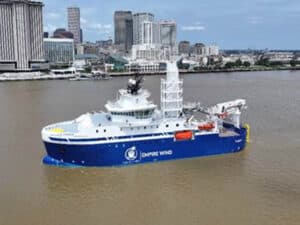
Stena Line installs wind turbines on ferry
Written by Stena Line is installing two wind turbines on the prow of the ferry Stena Jutlandica, which operates on the Gothenburg Sweden – Fredrikshaven,Denmark route. The turbines will both supplying energy and reduce fuel consumption by lowering air resistance.
Stena Line is installing two wind turbines on the prow of the ferry Stena Jutlandica, which operates on the Gothenburg Sweden – Fredrikshaven,Denmark route. The turbines will both supplying energy and reduce fuel consumption by lowering air resistance.
“Within our Energy Saving Programm, we are currently pursuing 200 environment improvement projects and this is yet another very interesting project. Stena Line has a tradition of leading when it comes to the development of different types of new solutions,” says Robert Akerlund, Director Technical & HR at Stena Line.

The two turbines will be mounted on 4 meter high masts on the prow of the ship. The two turbines will produce current for the ship’s electricity grid. Since they are to be placed on the prow, they will also contribute to a reduction in the air resistance.
“The two turbines will generate about 23,000 kWh per year, equivalent to the domestic electricity consumption for 4 normal homes during one year. Among other things, the electricity will be used to power the lighting on the Jutlandica’s car deck,” says Mr. Akerlund.
The reduced air resistance at sea will result in a reduction in fuel consumption of between 80 and 90 tonne per year.
“This can be compared to the consumption of oil for heating 28 homes during one year,” Mr. Akerlund says.
Stena Line’s operations in Scandinavia are already environmentally certified according to ISO 14001. There are electricity connections for all ships in Gothenburg and, during recent years, a number of environmental improvement measures have been implemented that have resulted in either reduced energy consumption or lower fuel consumption.
Facts:
Type:Vertical wind turbines
Generator capacity: 4 kW x 2
Estimated electricity supply:23,000 kWh/year, equivalent to the domestic electricity consumption for 4 homes per year.
Estimated fuel savings per year: 84 tonne, which is equivalent to heating 28 houses with oil per year. Resulting in a reduction in carbon dioxide emissions of 269 tonne/year and reduced sulfur emissions of 1.7 tonne/year.
June 23, 2011





Leave a Reply
You must be logged in to post a comment.